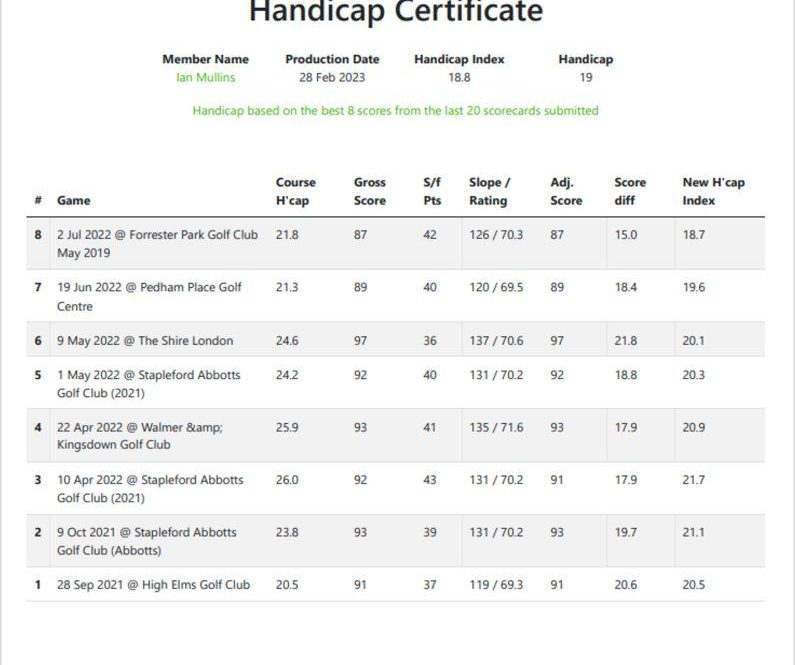Golf handicaps, a cornerstone of the sport, serve as a meticulous assessment of a player’s proficiency. This treatise delves into the multifaceted nature of golf handicaps, elucidating their fundamental components and underscoring their pivotal role in refining gameplay. Through a scholarly examination of handicapping factors, variations, and their interplay with course ratings, golfers acquire a profound comprehension of their abilities. Armed with this newfound knowledge, informed decisions regarding course selection and shot strategy become second nature, unlocking a transformative and strategic golf experience. Embarking on this journey of golf handicap analysis unlocks the gateway to optimizing gameplay, harnessing the full potential inherent within this captivating sport.

– Types of Golf Handicaps and Their Significance
Types of Golf Handicaps and Their Significance
Golf handicaps come in various types, each serving a specific purpose and offering unique benefits. Understanding the distinctions between these different handicaps is essential for golfers to make the most of this valuable resource.
Course Handicap: The most commonly used handicap, the course handicap is a measure of a golfer’s ability relative to a specific golf course. It takes into account the player’s historical scores, playing conditions, and the course’s difficulty rating. This handicap allows golfers to participate in tournaments and other competitive events, ensuring a fair and balanced playing field.
Playing Handicap: Designed for recreational play, the playing handicap adjusts a golfer’s course handicap based on the tees they are playing from. This type of handicap is calculated using a slope rating, which considers the difficulty of different tees on a given course. The playing handicap allows golfers to compete against each other on a more equitable level, regardless of the length or difficulty of the course they are playing.
* Index Handicap: The index handicap is a numerical representation of a player’s level of play calculated based on a golfer’s best scores over a long period of time. This handicap is essential for qualifying for certain tournaments and competitions, as it provides a standardized metric of skill level across different golf courses.
- Decoding the Handicap Calculation Formula: Understanding the Factors
Decoding the Handicap Calculation Formula: Understanding the Factors
The calculation of golf handicaps involves a meticulous assessment of several factors that collectively determine a golfer’s skill level. These factors are intricately interwoven to create a precise representation of a golfer’s performance and potential on the course.
The Average Score serves as the bedrock of handicap calculation. It represents the golfer’s typical score across a series of recent rounds, adjusted to reflect the difficulty of the courses played. The formula employs sophisticated algorithms to account for course conditions, such as slope and length, ensuring an accurate portrayal of a golfer’s ability.
Scores Used:
| Round | Score | Adjusted Score |
|—|—|—|
| 1 | 82 | 79 |
| 2 | 85 | 82 |
| 3 | 79 | 76 |
| … | … | … |
| N | 81 | 78 |
Other Key Factors:
Course Rating: A numerical representation of a course’s difficulty, considering factors such as length, hazards, and terrain.
Slope Rating: An indicator of a course’s difficulty relative to scratch golfers. Higher slope ratings signify greater challenges for higher-handicap players.
Differential: The difference between a golfer’s average score and the course rating, adjusted for the slope rating. The differential provides a standardized measure of a golfer’s performance.
Handicap Index: The cornerstone of a golfer’s handicap, calculated as the average of the best 8 differentials from the player’s last 20 rounds.
– Course Ratings and Handicaps: A Correlation for Optimized Gameplay
Course Ratings and Handicaps: A Correlation for Optimized Gameplay
Understanding course ratings is pivotal in gauging a course’s difficulty level and factoring it into gameplay strategy. Course ratings are calculated using a combination of factors, including hole yardage, fairway width, green size, and other elements influencing shot difficulty. This enables accurate handicap calculation by considering the course’s complexity and providing a fair assessment of player abilities.
Table 1: Course Rating Elements
| Element | Description |
|—|—|
| Yardage | Total distance of the course from the tee to the green |
| Fairway Width | Average width of the fairways |
| Green Size | Average size of the greens |
| Bunkers | Number and placement of bunkers |
| Water Hazards | Number and proximity of water hazards |
By correlating course ratings with handicaps, golfers can determine appropriate shot selection and strategize their approach accordingly. For instance, a player with a higher handicap may opt for more conservative shots on courses with higher ratings, while a lower handicap player may be more inclined to take risks on easier courses. Striking the right balance between course difficulty and handicap level is key to optimizing gameplay and maximizing enjoyment on the course.
– The Handicap Adjustment System: Ensuring Fair Play Across Courses
The Handicap Adjustment System: Ensuring Fair Play Across Courses
Handicap adjustment mechanisms play a vital role in ensuring equitable competition across courses of varying difficulty. The USGA Handicap System utilizes a Course Rating and Slope Rating system to calculate a course handicap that adjusts the player’s handicap index based on the specific course being played. This ensures that golfers are placed on a level playing field, regardless of the inherent challenges of the course they are tackling.
| Course Rating | Slope Rating |
|---|---|
| 72.0 | 135 |
| 70.0 | 125 |
| 68.0 | 115 |
A course rating represents the expected score for a scratch golfer (a player with a handicap index of 0) playing under normal course conditions. The slope rating measures the difficulty of the course relative to a scratch golfer. A higher slope rating indicates a more difficult course for golfers with higher handicaps. By utilizing these ratings, the handicap adjustment system ensures that players of all skill levels can compete fairly.
For instance, consider two golfers playing on different courses with the following ratings:
| Course A | Course B |
|---|---|
| Course Rating: 72.0 | Course Rating: 70.0 |
| Slope Rating: 135 | Slope Rating: 115 |
Despite having the same handicap index, the handicap adjustment system recognizes that the player on Course A will have a more challenging experience due to the higher course rating and slope rating. As a result, the player’s handicap will be adjusted upward to reflect this increased difficulty, ensuring a more balanced and competitive playing field.
– Leveraging Handicaps for Strategic Shot Planning and Course Selection
Leveraging Handicaps for Strategic Shot Planning and Course Selection
The information derived from handicaps is instrumental in developing tailored game plans for each course and hole. For instance, if a player has a handicap of 15, they can anticipate scoring an average of 15 strokes over par. Equipping oneself with this knowledge enables them to prudently assess their shot-making capacities and club selection.
When selecting a course, the handicap is a vital consideration. Choosing a layout that complements one’s handicap will enhance the overall golfing experience. For example, a golfer with a handicap of 18 might find a course with a par of 70 to be a suitable challenge. Conversely, attempting a more challenging track may lead to frustration and hinder their progress.
The data from golf handicaps translates directly into pragmatic decision-making on the course. Understanding the strengths and limitations presented by the handicap, players can execute sound strategy. For example, if a golfer has a handicap of 10 and is facing a par-5 hole, they may adopt a strategy of hitting a 3-wood off the tee, followed by a 5-iron approach to the green. This strategy harnesses their strengths and mitigates their weaknesses, leading to a higher likelihood of scoring within the confines of their handicap.
| Handicap | Recommended Course Par | Example Strategy |
| — | — | — |
| 15 | 72 | 3-wood tee shot, 5-iron approach on par-5 holes |
| 10 | 70 | Irons off the tee, focus on accuracy and consistency |
| 5 | 68 | Consider driver off the tee on most holes, aggressive approach shots |
a comprehensive understanding of golf handicaps unveils a world of strategic possibilities, enabling golfers to elevate their gameplay and fully embrace the intricacies of this timeless sport. By deciphering the components of their handicaps, correlating them with course ratings, and integrating this knowledge into their decision-making processes, golfers gain an unparalleled advantage. Golf handicaps are not mere numerical labels; they are invaluable tools that when fully understood and applied, empower players to unlock their full potential, refine their strategies, and experience the joy of this cherished game on a whole new level.





